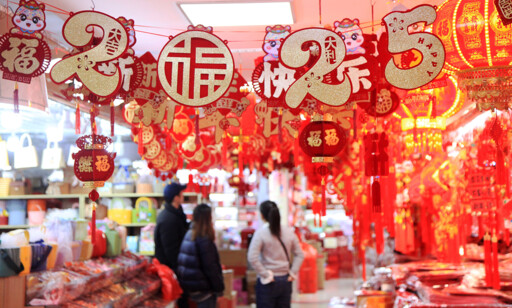


Scholars interpret new economic directives

Consumers shop at a New Year decorations market in Nanjing, Jiangsu Province, on Dec. 29, 2024. Photo: IC PHOTO
Academia has hailed the systematic arrangements for economic work in 2025, which was outlined at the Central Economic Work Conference held on Dec. 11–12, 2024, in Beijing, based on a comprehensive review of the economic performance in 2024 as well as the current situation. These directives have been recognized for laying a solid foundation and offering clear guidance for a good start to the 15th Five-Year Plan (2026–2030).
Coordinating five relationships
Over the past year, despite mounting external pressures and growing domestic challenges, the Chinese economy has maintained overall stability while achieving steady progress and high-quality development. The CPC Central Committee responded decisively to the evolving domestic and international landscape, introducing policies that emphasized the importance of coordinating five critical relationships: between an efficient market and an effective government, between aggregate supply and demand, between fostering new drivers and upgrading old ones, between optimizing incremental resources and making good use of existing resources, and between enhancing quality and expanding total output.
Sheng Bin, vice president of Nankai University, noted that the directive to properly manage the five relationships reflects a systematic, integrated approach to economic policymaking, rooted in a scientific understanding of the laws governing China’s economic development. At the core of this methodology lie efficiency, structure, and governance.
Sheng elaborated that “an effective government” underscores the need for economic order and structural reform, while “the relationship between aggregate supply and demand” highlights balance and alignment. “Fostering new drivers” focuses on developing new quality productive forces, “making good use of existing resources” stresses enhancing resource allocation efficiency, and “enhancing quality” underlines the pursuit of high-quality development.
Creating synergy for growth
At the Central Economic Work Conference, a “more proactive fiscal policy” was proposed for the first time, alongside an adjustment to the decade-long “prudent monetary policy,” now described as a “moderately loose monetary policy.” Li Xuesong, director of the Institute of Economics at the Chinese Academy of Social Sciences (CASS), explained that this adjustment aims to, through policy refinement, enhance economic stability and unlock growth potential in response to external uncertainties and domestic challenges.
In Li’s view, the more proactive fiscal policy would not only help stabilize growth and create employment, but also facilitate structural adjustments and drive technological innovation, advancing the transition from old growth drivers to new ones.
The conference prioritized “vigorously boosting consumption, improving investment efficiency, and expanding domestic demand on all fronts” as the top task for 2025. Fang Ying, vice president of Xiamen University, observed that the CPC Central Committee has recognized inadequate domestic demand as the primary challenge facing the economy. Against the backdrop of a more proactive fiscal policy and moderately loose monetary policy, expanding domestic demand on all fronts by vigorously boosting consumption and improving investment efficiency will be instrumental in ensuring steady progress and stability in the coming year. Fang added that these efforts are crucial for accelerating the building of a new development paradigm and advancing Chinese modernization by deepening reform comprehensively.
Another key focus of the conference was on “strengthening expectation management and coordinating policy implementation with expectation guiding, thereby enhancing policy guidance and influence.” He Dexu, director of the National Academy of Economic Strategy at CASS, stated that policy effectiveness relies on effectively guiding expectations, which have self-realizing and self-reinforcing characteristics. Stabilizing expectations and bolstering confidence, He Dexu said, are pivotal for the successful implementation of macroeconomic policies and for fostering high-quality development.
The meeting also called for “addressing irrational rat-race competition and regulating behaviors of local governments and enterprises,” acknowledging that this issue has evolved from a localized concern into a comprehensive challenge to high-quality development nationwide. The alteration from “strengthening industrial self-discipline to prevent irrational rat-race competition,” required at the meeting of the Political Bureau of the CPC Central Committee on July 30, 2024, to “addressing irrational rat-race competition and regulating behaviors of local governments and enterprises,” demonstrates the CPC Central Committee’s resolve to eradicate this problem through coordinated policies.
Qu Yongyi, Party secretary of CASS’s Institute of Industrial Economics, pointed out that irrational rat-race competition is manifested in excessive industrial investment and short-term competition approaches like price wars, leading to declining capacity utilization and profitability. Some enterprises even resort to unfair competition that disrupts market order and undermines their own reputation and competitiveness. This phenomenon stems from the short-sighted decisions by local governments and enterprises that are driven by misguided reliance on economies of scale, thin margins, and hopes of future market dominance. Protectionism by regional governments and irregular practices to attract capital are also to blame.
Qu affirmed that addressing irrational rat-race competition is essential to spurring healthy market competition and industrial upgrading, thereby advancing high-quality industrial development. In terms of industrial layout, this strategy can sidestep the trap of industrial homogenization across regions, fueling synergistic industrial growth among them. Within industries, it can avert low-level competitive traps, channeling factor resources toward technological innovation and industrial upgrading. For enterprises, only by curbing irrational rat-race competition and fostering a healthy growth environment can they avoid the pitfalls of low-quality development and truly embark on a path of innovation-driven, sustainable development.
Editor:Yu Hui
Copyright©2023 CSSN All Rights Reserved